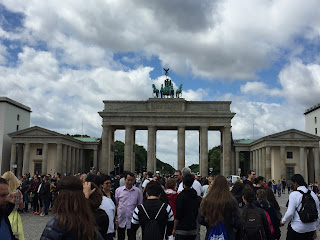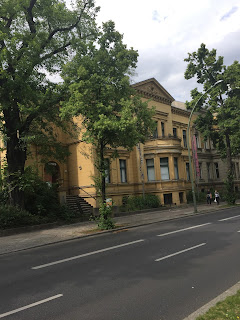On Monday I took a LOT more pictures than the day before. So
here we go!
We all woke up to a somewhat rainy Monday morning for some
breakfast and last-minute reading before taking the trains to Humboldt
University. At 10 am, we attended Dr. Viola Georgi’s Lecture on History
Learning, Memory, and Migration. She talked about how the way history is
typically taught around the world doesn’t account for alternative narratives,
and we discussed how history teaching methods and curriculums should be
changing in this era of migration so that students with diverse identities can
connect to history. I think this lecture connected really well with the themes
of our course; it especially drew my mind back to our Age of Migration readings
and the discussion on the formation of transnational communities. It seems
that, while transnational communities are forming, educators are struggling to
accommodate for the diverse and complex communities in which they are teaching.
I think many of us initially focused on the issues of differences in language
in a transnational community and how that might cause some practical
challenges, but Dr. Georgi’s lecture emphasized how challenging it is to cross
the historical barrier as well.
After the lecture, we split up and planned to reconvene at 2
pm (except for Catherine, Laurette, Ally and Katie, who each went to their
community placements). Some people went back to Die Fabrik, others went in
search of “The Cheap Pasta Place”, and Clayton, Zosia, Katie and I went to take
photos as the Brandenburg Gates. We took a LOT of photos.
After grabbing some lunch back in Kreuzberg, Zosia and
Clayton led all of us to the Youth Museum in Schöneberg.
The museum is in a beautiful villa, in a neighborhood that
our guides Heinz and Clara explained was, historically, quite wealthy. Which
might explain the golden deer fountain…
It has been interesting to see how the nearly ancient
history of this city is still impacting the demographic formation of the city
today. Even after hundreds of years, Schöneberg is still a relatively wealthier
neighborhood, even as it acquired more diversity in its demographics. I wonder
if this pattern can still be seen in all cities, because it can certainly still
be seen in Seattle with residential areas of the city that were segregated by
race. This segregation was enforced by city policy until 1968, just a few weeks
after Martin Luther King Jr.’s assassination, but the history has seemingly
left its mark. (Maps complied by a project through the UW show the distribution
of different racial communities over time, and Seattle is still dominated by
white people). So, we must ask the question: must the demographic history of a
neighborhood heavily impact its future community?
The museum had rooms that were created by people who live in
the community. Each room has artifacts and quotes that create a picture of the
person’s life, and children that come to the museum act as reporters,
collecting details from the room to figure out who this person is and what
their life is like. Personally, I really enjoyed exploring the rooms made by
people of seemingly contrasting identities; for example, some rooms were made
by people whose families celebrated both Christian and Muslim holidays. It
reminded me of an article we read in the seminar about an author with a
“migrational background” who writes in German when people expect her to only
write about her experience of migration; your family history, race, and
language are a significant portion of identity, but they don’t have to dictate
everything you do in life, or everyone you spend time with. The museum was
really unique, and I think the group as a whole really enjoyed it, despite the
fact that the target audience is much younger than us. It was also really cool
to see Zosia and Clayton talking about their experiences working with the Youth
Museum as their community partner, and it felt like we had more of an insider’s
scoop on the museum thanks to their perspectives and experience working with
the museum during the day.
After the museum, we all went our separate ways for the
evening, so that’s about it for Monday! Thanks for reading!
P.S. Shout out to the group of people who crossed the busy
street to get from the museum to the supermarket and successfully avoided
getting hit by cars. GO TEAM!








No comments:
Post a Comment